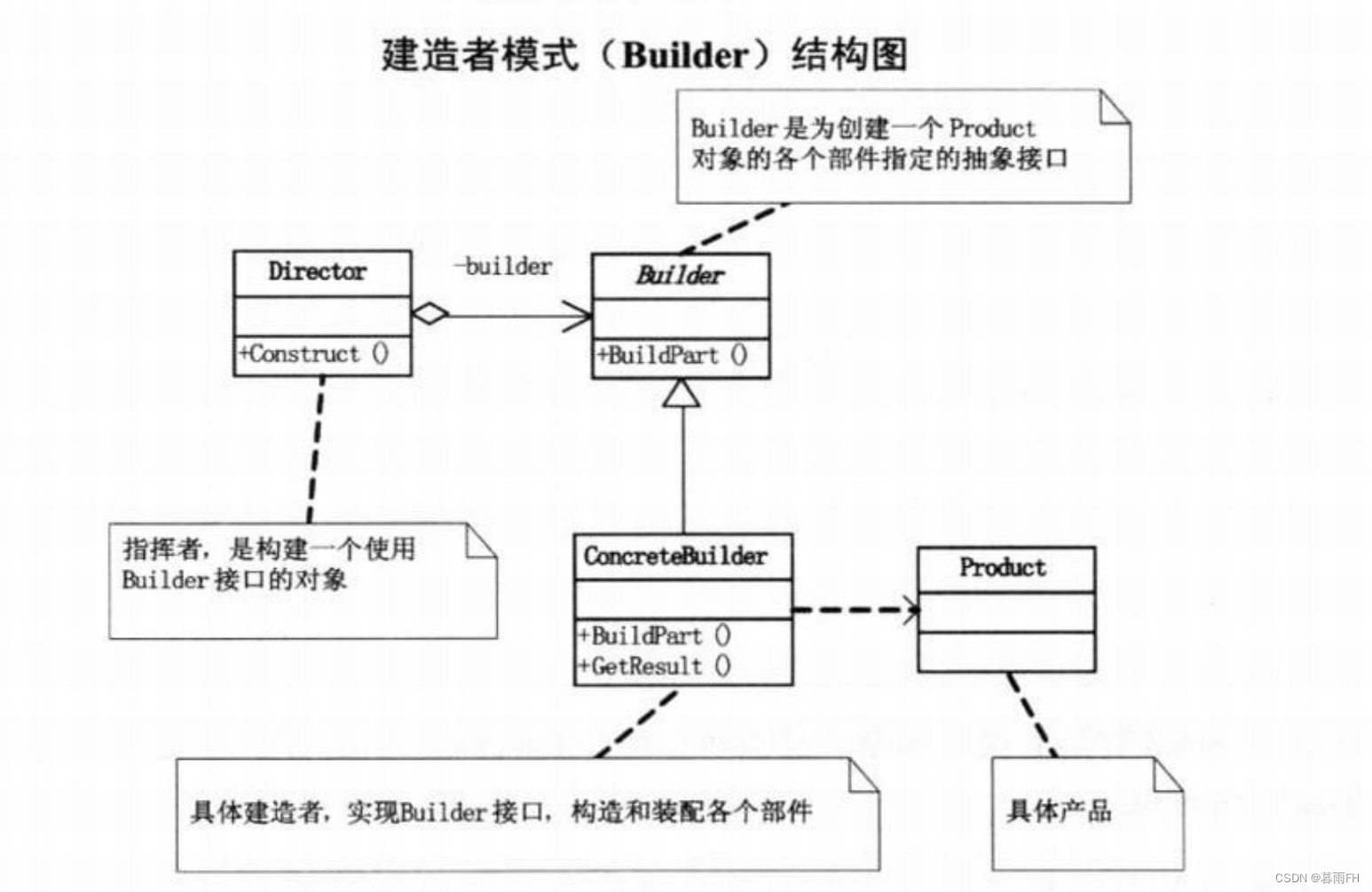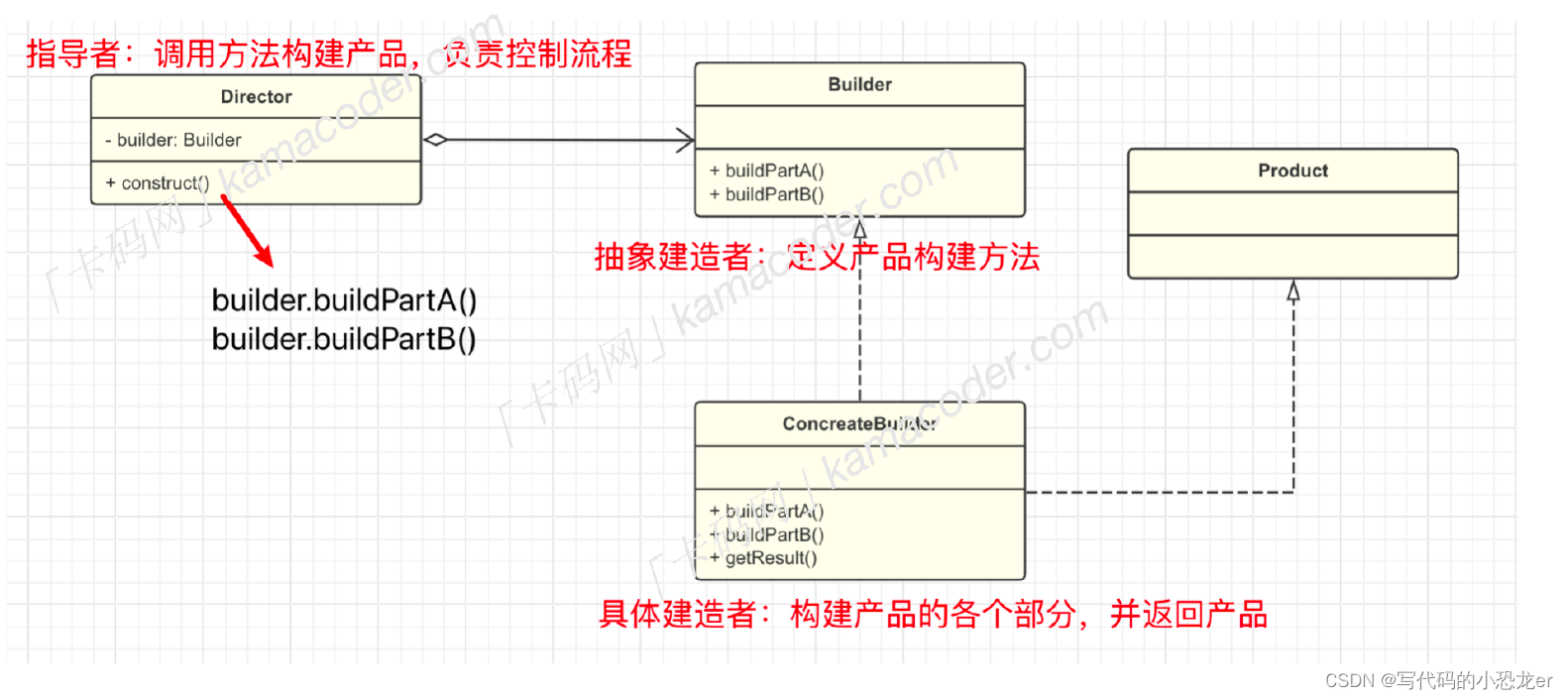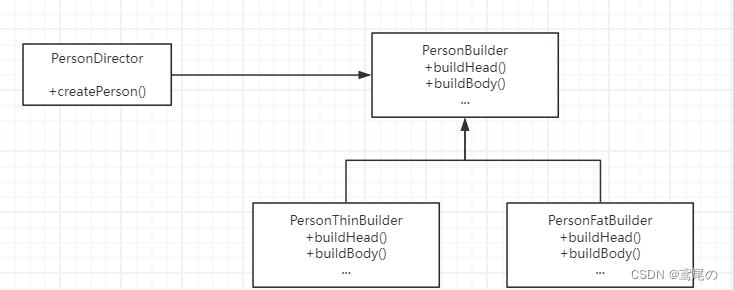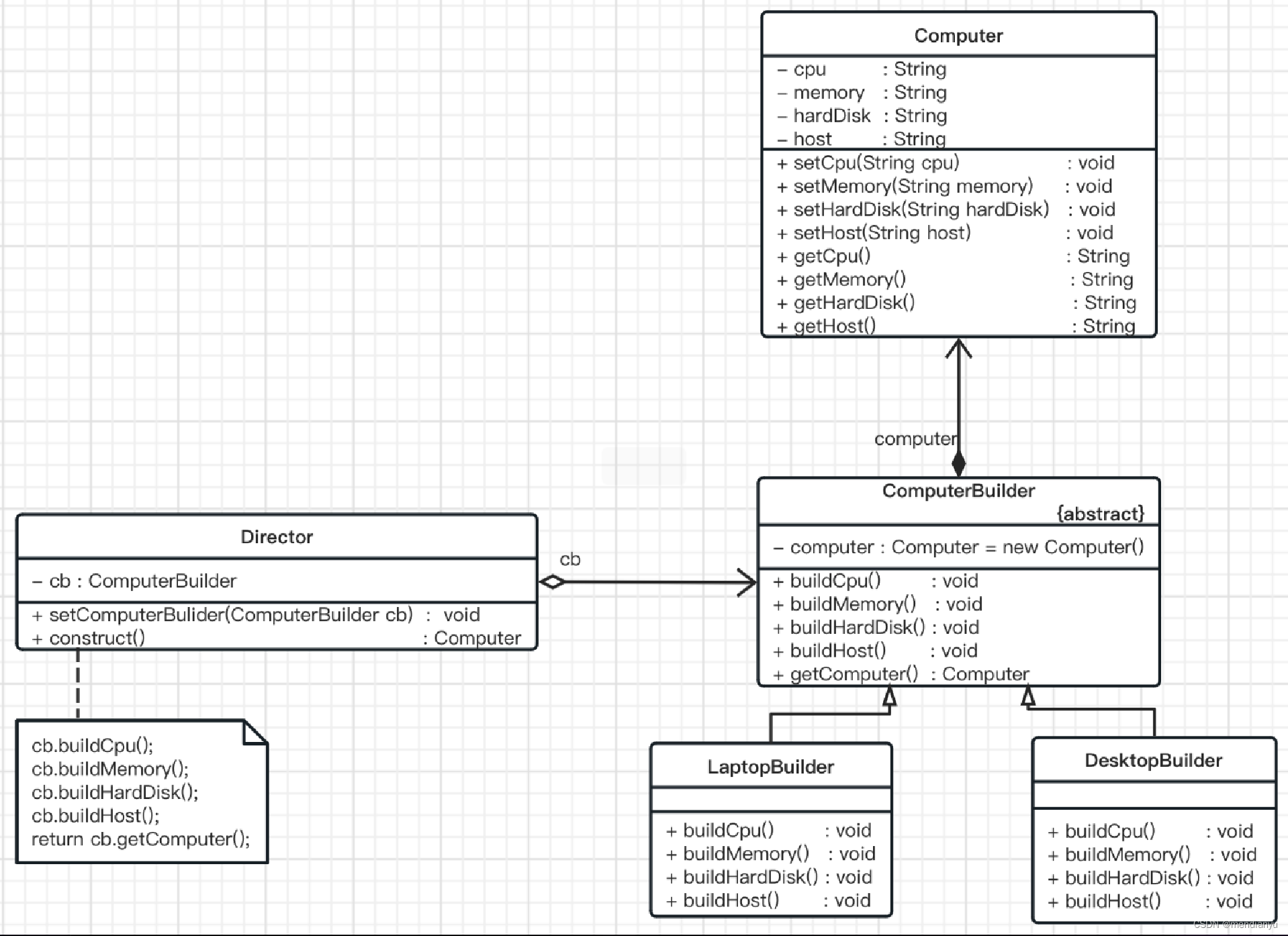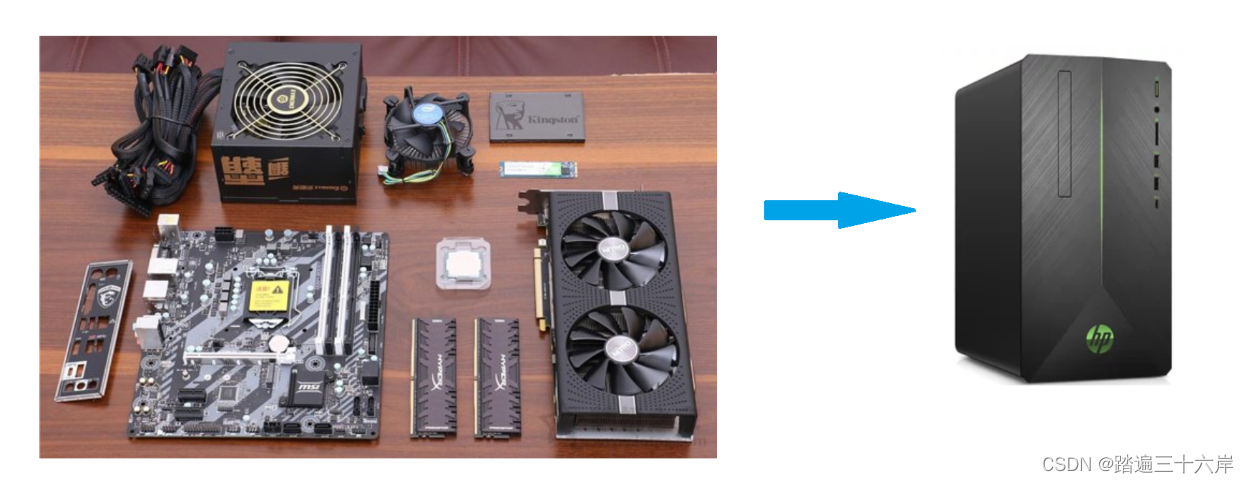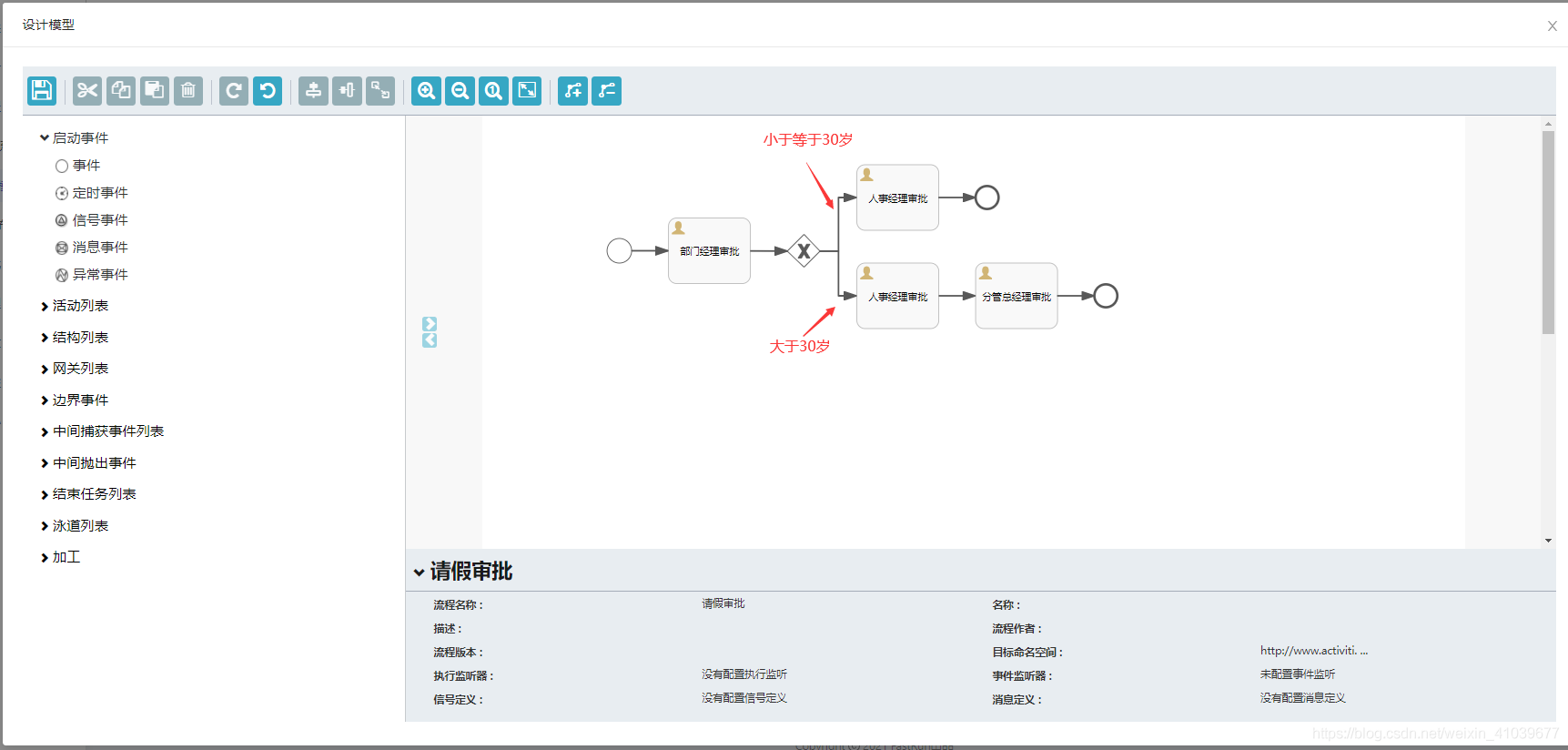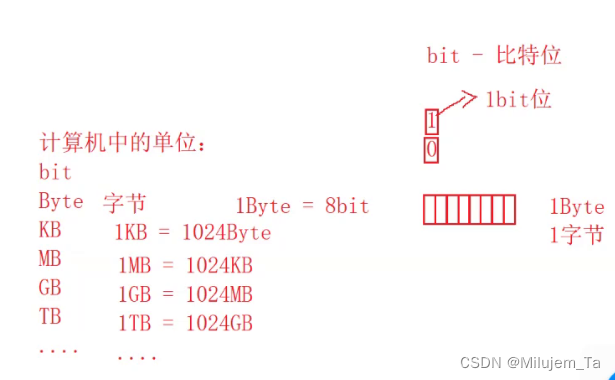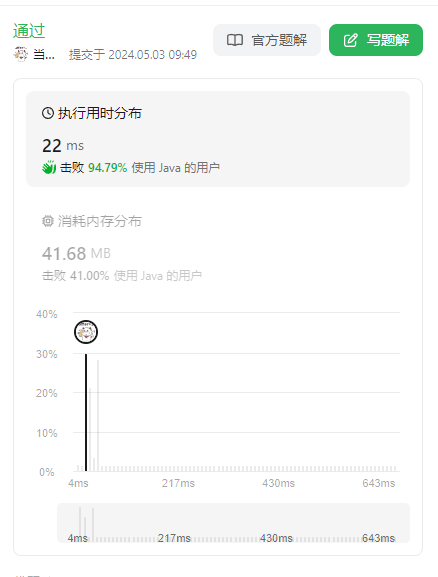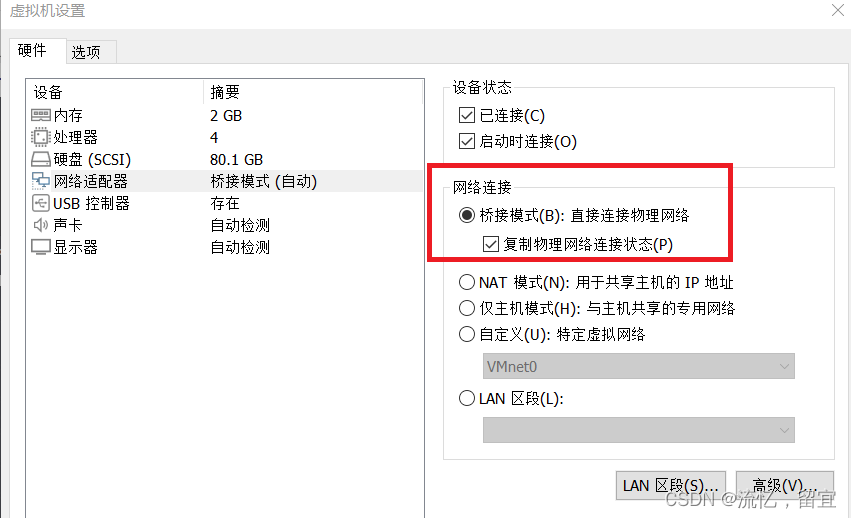一 什么是建造者模式?
// 小木公司对于SQL有配置,因此要输入sql url,然后输入 sql username,然后是 sql ps
//因此小木就想到了使用 SystemConfig这个类来完成上述的三个初始化
//5.1号小木公司加入了redis的缓存机制,redis也有 url,username,password,三个字符串
//10.1之后,小木公司加入了kafka机制,让log都存储到kafka中,kafka也有url,username,password,三个字符串
//说不定过年后,还有加上其他配置项。这时候小木意识到问题的严重性了,
//每次改动都一堆参数,且容易出现问题
// 小木公司对于SQL有配置,因此要输入sql url,然后输入 sql username,然后是 sql ps
//因此小木就想到了使用 SystemConfig这个类来完成上述的三个初始化
//5.1号小木公司加入了redis的缓存机制,redis也有 url,username,password,三个字符串
//10.1之后,小木公司加入了kafka机制,让log都存储到kafka中,kafka也有url,username,password,三个字符串
//说不定过年后,还有加上其他配置项。这时候小木意识到问题的严重性了,
//每次改动都一堆参数,且容易出现问题
#include <iostream>
#include <string>
using namespace std;
class SystemConfig {
public:
SystemConfig(string sqlurl,string sqlusername,string sqlpassword,
string redisurl, string redisusername, string redispassword,
string kafkaurl, string kafkausername, string kafkapassword)
: MySQL_URL(sqlurl), MySQL_username(sqlusername), MySQL_password(sqlpassword),
REDIS_URL(redisurl), REDIS_username(redisusername), REDIS_password(redispassword),
KAFKA_URL(kafkaurl), KAFKA_username(kafkausername), KAFKA_password(kafkapassword)
{
}
void printfSysConfig() {
cout << "MySQL_URL = " << MySQL_URL
<< " MySQL_username = " << MySQL_username
<< " MySQL_password = " << MySQL_password
<< " REDIS_URL = " << REDIS_URL
<< " REDIS_username = " << REDIS_username
<< " REDIS_password = " << REDIS_password
<< " KAFKA_URL = " << KAFKA_URL
<< " KAFKA_username = " << KAFKA_username
<< " KAFKA_password = " << KAFKA_password
<< endl;
}
private:
string MySQL_URL;
string MySQL_username;
string MySQL_password;
//5.1之后
string REDIS_URL;
string REDIS_username;
string REDIS_password;
//10.1之后
string KAFKA_URL;
string KAFKA_username;
string KAFKA_password;
};
//想到的第一解决方案是:我们将这些属性都弄成函数,
class SystemConfig1 {
public:
SystemConfig1() {
}
void setMySQLConfig(string sqlurl, string sqlusername, string sqlpassword) {
this->MySQL_URL = sqlurl;
this->MySQL_username = sqlusername;
this->MySQL_password = sqlpassword;
}
void setRedisConfig(string redisurl, string redisusername, string redispassword) {
this->REDIS_URL = redisurl;
this->REDIS_username = redisusername;
this->REDIS_password = redispassword;
}
void setKAFKAConfig(string kafkaurl, string kafkausername, string kafkapassword) {
this->KAFKA_URL = kafkaurl;
this->KAFKA_username = kafkausername;
this->KAFKA_password = kafkapassword;
}
void printfSysConfig() {
cout << "MySQL_URL = " << MySQL_URL
<< " MySQL_username = " << MySQL_username
<< " MySQL_password = " << MySQL_password
<< " REDIS_URL = " << REDIS_URL
<< " REDIS_username = " << REDIS_username
<< " REDIS_password = " << REDIS_password
<< " KAFKA_URL = " << KAFKA_URL
<< " KAFKA_username = " << KAFKA_username
<< " KAFKA_password = " << KAFKA_password
<< endl;
}
private:
string MySQL_URL;
string MySQL_username;
string MySQL_password;
//5.1之后
string REDIS_URL;
string REDIS_username;
string REDIS_password;
//10.1之后
string KAFKA_URL;
string KAFKA_username;
string KAFKA_password;
};
//构造者模式
//创建一个sustemconfig的build类,创建systemconfig的过程全都交给这个systemconfig类来实现
class SystemConfig2 {
public:
SystemConfig2() {
}
void printfSysConfig() {
cout << "MySQL_URL = " << MySQL_URL
<< " MySQL_username = " << MySQL_username
<< " MySQL_password = " << MySQL_password
<< " REDIS_URL = " << REDIS_URL
<< " REDIS_username = " << REDIS_username
<< " REDIS_password = " << REDIS_password
<< " KAFKA_URL = " << KAFKA_URL
<< " KAFKA_username = " << KAFKA_username
<< " KAFKA_password = " << KAFKA_password
<< endl;
}
public:
string MySQL_URL;
string MySQL_username;
string MySQL_password;
//5.1之后
string REDIS_URL;
string REDIS_username;
string REDIS_password;
//10.1之后
string KAFKA_URL;
string KAFKA_username;
string KAFKA_password;
};
class SystemConfig2Build {
public:
SystemConfig2Build() {
}
SystemConfig2 & getSystemConfig() {
return systemconfig;
}
void setMySQLConfig(string sqlurl, string sqlusername, string sqlpassword) {
systemconfig.MySQL_URL = sqlurl;
systemconfig.MySQL_username = sqlusername;
systemconfig.MySQL_password = sqlpassword;
}
void setRedisConfig(string redisurl, string redisusername, string redispassword) {
systemconfig.REDIS_URL = redisurl;
systemconfig.REDIS_username = redisusername;
systemconfig.REDIS_password = redispassword;
}
void setKAFKAConfig(string kafkaurl, string kafkausername, string kafkapassword) {
systemconfig.KAFKA_URL = kafkaurl;
systemconfig.KAFKA_username = kafkausername;
systemconfig.KAFKA_password = kafkapassword;
}
private:
SystemConfig2 systemconfig;
};
class CompanyA {
public:
virtual SystemConfig2 & buildSystemConfig() {
scbuild2.setMySQLConfig("11a", "22a", "33a");
scbuild2.setRedisConfig("44a", "55a", "66a");
scbuild2.setKAFKAConfig("77a", "88a", "99a");
return scbuild2.getSystemConfig();
}
private:
SystemConfig2Build scbuild2;
};
class CompanyB {
public:
SystemConfig2 & buildSystemConfig() {
scbuild2.setMySQLConfig("11B", "22B", "33B");
scbuild2.setRedisConfig("44B", "55B", "66B");
scbuild2.setKAFKAConfig("77B", "88B", "99B");
return scbuild2.getSystemConfig();
}
private:
SystemConfig2Build scbuild2;
};
class CompanyDiect {
public:
virtual SystemConfig2 & buildSystemConfig() = 0;
virtual ~CompanyDiect() {//注意父类的 析构函数 要写成 virtual形式的。
}
private:
SystemConfig2Build scbuild2;
};
//c公司
class CompanyDiectc:public CompanyDiect {
public:
virtual SystemConfig2 & buildSystemConfig() {
scbuild2.setMySQLConfig("11c", "22c", "33c");
scbuild2.setRedisConfig("44c", "55c", "66c");
scbuild2.setKAFKAConfig("77c", "88c", "99c");
return scbuild2.getSystemConfig();
}
private:
SystemConfig2Build scbuild2;
};
class CompanyDiectd :public CompanyDiect {
public:
virtual SystemConfig2 & buildSystemConfig() {
scbuild2.setMySQLConfig("11d", "22d", "33d");
scbuild2.setRedisConfig("44d", "55d", "66d");
scbuild2.setKAFKAConfig("77d", "88d", "99d");
return scbuild2.getSystemConfig();
}
private:
SystemConfig2Build scbuild2;
};
int main()
{
_CrtSetDbgFlag(_CRTDBG_ALLOC_MEM_DF | _CRTDBG_LEAK_CHECK_DF);//程序退出时检测内存泄漏并显示到“输出”窗口
std::cout << "Hello World!\n";
SystemConfig sc = SystemConfig("aa","bb","cc","dd","ee","ff","11","22","33");
sc.printfSysConfig();
//首先想到的fix方案,但是有个问题,就是开出来了public接口,让user可以调用,这不怎么好。
//也就是说破坏了原有的systemConfig的封装性,让user可以有机会再次改动。虽然不得不这么干。
SystemConfig1 sc1 = SystemConfig1();
sc1.setMySQLConfig("SQL11", "SQL22", "SQL33");
sc1.setRedisConfig("redis1", "redis2", "redis3");
sc1.setKAFKAConfig("kafka1", "kafka2", "kafka3");
sc1.printfSysConfig();
//构造者模式的调用
SystemConfig2Build scbuild2;
scbuild2.setMySQLConfig("11", "22", "33");
scbuild2.setRedisConfig("44", "55", "66");
scbuild2.setKAFKAConfig("77", "88", "99");
SystemConfig2 sc2 = scbuild2.getSystemConfig();
sc2.printfSysConfig();
//我们看到上述构造者模式的调用,每次都要传递参数进入,实际开发中,我们可能对于A,B公司的配置基本是不变的,也就是说,我们需要一些预选项
CompanyA ca;
SystemConfig2 sca = ca.buildSystemConfig();
sca.printfSysConfig();
//B公司
CompanyB cB;
SystemConfig2 scB = cB.buildSystemConfig();
scB.printfSysConfig();
//我们看代码知道 CompanyA 和 CompanyB 的代码是完全一样的,因此可以抽取成父类,这样
CompanyDiect * comabs;
comabs = new CompanyDiectc(); //多态完成
SystemConfig2 scconn = comabs->buildSystemConfig();
scconn.printfSysConfig();
delete comabs;
}
建造者模式(也被成为⽣成器模式),是⼀种创建型设计模式,软件开发过程中有的时候需要创建很复杂的对象,⽽建造者模式的主要思想是将对象的构建过程分为多个步骤,并为每个步骤定义⼀个抽象的接⼝。具体的构建过程由实现了这些接⼝的具体建造者类来完成。同时有⼀个指导者类负责协调建造者的⼯作,按照⼀定的顺序或逻辑来执⾏构建步骤,最终⽣成产品。
举个例⼦,假如我们要创建⼀个计算机对象,计算机由很多组件组成,例如 CPU、内存、硬盘、显卡等。每个组件可能有不同的型号、配置和制造,这个时候计算机就可以被视为⼀个复杂对象,构建过程相对复杂,⽽我们使⽤建造者模式将计算机的构建过程封装在⼀个具体的建造者类中,⽽指导者类则负责指导构建的步骤和顺序。每个具体的建造者类可以负责构建不同型号或配置的计算机,客户端代码可以通过选择不同的建造者来创建不同类型的计算机,这样就可以根据需要构建不同表示的复杂对象,更加灵活。
假设我们要创建一个计算机对象,普通的写法如下:
// 004构建者模式.cpp : 此文件包含 "main" 函数。程序执行将在此处开始并结束。
//
#include <iostream>
#include <string>
using namespace std;
//cpu
class CPU {
public:
CPU(string cpuname) :_cpuname(cpuname) {
cout << "CPU 构造方法被调用 _cpuname = " << _cpuname << endl;
}
public:
string _cpuname;
};
class Memory {
public:
Memory(string memname) :_memname(memname) {
cout << "Memory 构造方法被调用 _memname = " << memname << endl;
}
public:
string _memname;
};
class Harddisk {
public:
Harddisk(string diskname) :_diskname(diskname) {
cout << "Harddisk 构造方法被调用 diskname = " << diskname << endl;
}
public:
string _diskname;
};
class GraphicsCard {
public:
GraphicsCard(string gcname) :_gcname(gcname) {
cout << "GraphicsCard 构造方法被调用 _gcname = " << _gcname << endl;
}
public:
string _gcname;
};
//如果是普通的写法
//假如我们要创建⼀个计算机对象,计算机由很多组件组成,
//例如 CPU、内存、硬盘、显卡等。
//每个组件可能有不同的型号、配置和制造,
//这个时候计算机就可以被视为⼀个复杂对象
class Computer {
public:
Computer(CPU *cpu, Memory *mem, Harddisk *hdisk, GraphicsCard *gc)
:_cpu(cpu),_mem(mem),_hdisk(hdisk),_gc(gc) {
cout << "Computer 构造方法被调用" << endl;
}
~Computer() {
cout << "Computer 析构方法被调用" << endl;
}
void printfCom() {
cout << "cpu = " << this->_cpu->_cpuname
<< " mem = " << this->_mem->_memname
<< " hdisk = " << this->_hdisk->_diskname
<< " gc = " << this->_gc->_gcname
<<endl;
}
protected:
CPU *_cpu;
Memory *_mem;
Harddisk *_hdisk;
GraphicsCard *_gc;
};
int main()
{
std::cout << "Hello World!\n";
CPU cpu("intelcpu");
Memory mem("sanxingmem");
Harddisk disk("xindisk");
GraphicsCard gc("huaweixianka");
Computer comA(&cpu,&mem,&disk,&gc);
comA.printfCom();
//这里有个问题,如果我们创建的cpmputer比较多,又有不同的型号,那么很容易写错。
//创建者模型就是解决这个问题
}
和继承的写法结合在一起
// 004构建者模式正确的写法.cpp : 此文件包含 "main" 函数。程序执行将在此处开始并结束。
//
#include <iostream>
#include <string>
using namespace std;
//使用构造者模式创建
class CPUBase {
public:
CPUBase(string cpuname) :_cpuname(cpuname) {
cout << "CPUBase 构造方法被调用 _cpuname = " << _cpuname << endl;
}
public:
string _cpuname;
};
class HuaweiCpu : public CPUBase {
public:
HuaweiCpu(string cpuname) :CPUBase(cpuname) {
cout << "HuaweiCpu 构造方法被调用 _cpuname = " << _cpuname << endl;
}
};
class xiaomiCpu : public CPUBase {
public:
xiaomiCpu(string cpuname) :CPUBase(cpuname) {
cout << "xiaomiCpu 构造方法被调用 _cpuname = " << _cpuname << endl;
}
};
class lianxiangCpu : public CPUBase {
public:
lianxiangCpu(string cpuname) :CPUBase(cpuname) {
cout << "lianxiangCpu 构造方法被调用 _cpuname = " << _cpuname << endl;
}
};
class MemoryBase {
public:
MemoryBase(string memname) :_memname(memname) {
cout << "MemoryBase 构造方法被调用 _memname = " << memname << endl;
}
public:
string _memname;
};
class huaweiMemory :public MemoryBase {
public:
huaweiMemory(string memname) :MemoryBase(memname) {
cout << "huaweiMemory 构造方法被调用 _memname = " << memname << endl;
}
};
class xiaomiMemory :public MemoryBase {
public:
xiaomiMemory(string memname) :MemoryBase(memname) {
cout << "xiaomiMemory 构造方法被调用 _memname = " << memname << endl;
}
};
class lianxiangMemory :public MemoryBase {
public:
lianxiangMemory(string memname) :MemoryBase(memname) {
cout << "lianxiangMemory 构造方法被调用 _memname = " << memname << endl;
}
};
class HarddiskBase {
public:
HarddiskBase(string diskname) :_diskname(diskname) {
cout << "HarddiskBase 构造方法被调用 diskname = " << diskname << endl;
}
public:
string _diskname;
};
class huaweiHarddisk :public HarddiskBase {
public:
huaweiHarddisk(string diskname) :HarddiskBase(diskname) {
cout << "huaweiHarddisk 构造方法被调用 _diskname = " << diskname << endl;
}
};
class xiaomiHarddisk :public HarddiskBase {
public:
xiaomiHarddisk(string diskname) :HarddiskBase(diskname) {
cout << "xiaomiHarddisk 构造方法被调用 diskname = " << diskname << endl;
}
};
class lianxiangHarddisk :public HarddiskBase {
public:
lianxiangHarddisk(string diskname) :HarddiskBase(diskname) {
cout << "lianxiangHarddisk 构造方法被调用 diskname = " << diskname << endl;
}
};
class GraphicsCardBase {
public:
GraphicsCardBase(string gcname) :_gcname(gcname) {
cout << "GraphicsCardBase 构造方法被调用 _gcname = " << _gcname << endl;
}
public:
string _gcname;
};
class huaweiGraphicsCard :public GraphicsCardBase {
public:
huaweiGraphicsCard(string gcname) :GraphicsCardBase(gcname) {
cout << "huaweiHarddisk 构造方法被调用 gcname = " << gcname << endl;
}
};
class xiaomiGraphicsCard :public GraphicsCardBase {
public:
xiaomiGraphicsCard(string gcname) :GraphicsCardBase(gcname) {
cout << "xiaomiGraphicsCard 构造方法被调用 gcname = " << gcname << endl;
}
};
class lianxiangGraphicsCard :public GraphicsCardBase {
public:
lianxiangGraphicsCard(string gcname) :GraphicsCardBase(gcname) {
cout << "lianxiangGraphicsCard 构造方法被调用 gcname = " << gcname << endl;
}
};
class ComputerBase {
public:
virtual ~ComputerBase() {};
void printComputerBase() {
cout << "_cpuBase = " << this->_cpuBase
<< " _memBase = " << this->_memBase
<< " _hdiskBase = " << this->_hdiskBase
<< " _gcBase = " << this->_gcBase
<< endl;
}
// 一般需要给私有的成员属性提供读写接口
CPUBase* GetCPUBase() {
return this->_cpuBase;
}
void SetCPUBase(CPUBase* cpubase) {
this->_cpuBase = cpubase;
}
MemoryBase* GetMemoryBase() {
return this->_memBase;
}
void SetMemoryBase(MemoryBase* membase) {
this->_memBase = membase;
}
HarddiskBase* GetHarddiskBase() {
return this->_hdiskBase;
}
void SetHarddiskBase(HarddiskBase* hdiskBase) {
this->_hdiskBase = hdiskBase;
}
GraphicsCardBase* GetGraphicsCardBase() {
return this->_gcBase;
}
void SetGraphicsCardBase(GraphicsCardBase* gcBase) {
this->_gcBase = gcBase;
}
protected:
CPUBase *_cpuBase;
MemoryBase *_memBase;
HarddiskBase *_hdiskBase;
GraphicsCardBase *_gcBase;
};
class huaweiComputer :public ComputerBase {
};
class lianxiangComputer :public ComputerBase {
};
class xiaomiComputer :public ComputerBase {
};
//构建器父类
class ComputerBaseBuilder {
public:
virtual ~ComputerBaseBuilder() {};
virtual void loadCPU(string cpubase) = 0;
virtual void loadMem(string membase) = 0;
virtual void loaddisk(string diskbase) = 0;
virtual void loadGraphicsCard(string graphicsCardbase) = 0;
ComputerBase * getCompBase() {
return m_compBase;
}
protected:
ComputerBase *m_compBase;
};
class huaweiComputerBuild :public ComputerBaseBuilder {
public:
huaweiComputerBuild() {
m_compBase = new huaweiComputer();
}
virtual void loadCPU(string strmodelno) {
CPUBase *cpu = nullptr;
if (strmodelno == "001") {
cpu = new HuaweiCpu("huaweicpu");
}
if (strmodelno == "002") {
cpu = new xiaomiCpu("xiaomicpu");
}
if (strmodelno == "003") {
cpu = new lianxiangCpu("lianxiangcpu");
}
cout << "huaweiComputerBuild loadCPU" << endl;
m_compBase->SetCPUBase(cpu);
}
virtual void loadMem(string strmodelno) {
MemoryBase *memBase = nullptr;
if (strmodelno == "001") {
memBase = new huaweiMemory("huaweimemory");
}
if (strmodelno == "002") {
memBase = new xiaomiMemory("xiaomimemory");
}
if (strmodelno == "003") {
memBase = new lianxiangMemory("lianxiangmemory");
}
cout << "huaweiComputerBuild loadmemory" << endl;
m_compBase->SetMemoryBase(memBase);
}
virtual void loaddisk(string strmodelno) {
HarddiskBase *hdiskBase = nullptr;
if (strmodelno == "001") {
hdiskBase = new huaweiHarddisk("huaweidisk");
}
if (strmodelno == "002") {
hdiskBase = new xiaomiHarddisk("xiaomidisk");
}
if (strmodelno == "003") {
hdiskBase = new lianxiangHarddisk("lianxiangdisk");
}
cout << "huaweiComputerBuild loaddisk" << endl;
m_compBase->SetHarddiskBase(hdiskBase);
}
virtual void loadGraphicsCard(string strmodelno) {
GraphicsCardBase *_gcBase = nullptr;
if (strmodelno == "001") {
_gcBase = new huaweiGraphicsCard("huaweigc");
}
if (strmodelno == "002") {
_gcBase = new xiaomiGraphicsCard("huaweigc");
}
if (strmodelno == "003") {
_gcBase = new lianxiangGraphicsCard("huaweigc");
}
cout << "huaweiComputerBuild loadgcbase" << endl;
m_compBase->SetGraphicsCardBase(_gcBase);
}
~huaweiComputerBuild() {
}
};
class lianxiangComputerBuild :public ComputerBaseBuilder {
public:
lianxiangComputerBuild() {
m_compBase = new lianxiangComputer();
}
virtual void loadCPU(string strmodelno) {
CPUBase *cpu = nullptr;
if (strmodelno == "001") {
cpu = new HuaweiCpu("huaweicpu");
}
if (strmodelno == "002") {
cpu = new xiaomiCpu("xiaomicpu");
}
if (strmodelno == "003") {
cpu = new lianxiangCpu("lianxiangcpu");
}
cout << "huaweiComputerBuild loadCPU" << endl;
m_compBase->SetCPUBase(cpu);
}
virtual void loadMem(string strmodelno) {
MemoryBase *memBase = nullptr;
if (strmodelno == "001") {
memBase = new huaweiMemory("huaweimemory");
}
if (strmodelno == "002") {
memBase = new xiaomiMemory("xiaomimemory");
}
if (strmodelno == "003") {
memBase = new lianxiangMemory("lianxiangmemory");
}
cout << "huaweiComputerBuild loadmemory" << endl;
m_compBase->SetMemoryBase(memBase);
}
virtual void loaddisk(string strmodelno) {
HarddiskBase *hdiskBase = nullptr;
if (strmodelno == "001") {
hdiskBase = new huaweiHarddisk("huaweidisk");
}
if (strmodelno == "002") {
hdiskBase = new xiaomiHarddisk("xiaomidisk");
}
if (strmodelno == "003") {
hdiskBase = new lianxiangHarddisk("lianxiangdisk");
}
cout << "huaweiComputerBuild loaddisk" << endl;
m_compBase->SetHarddiskBase(hdiskBase);
}
virtual void loadGraphicsCard(string strmodelno) {
GraphicsCardBase *_gcBase = nullptr;
if (strmodelno == "001") {
_gcBase = new huaweiGraphicsCard("huaweigc");
}
if (strmodelno == "002") {
_gcBase = new xiaomiGraphicsCard("huaweigc");
}
if (strmodelno == "003") {
_gcBase = new lianxiangGraphicsCard("huaweigc");
}
cout << "huaweiComputerBuild loadgcbase" << endl;
m_compBase->SetGraphicsCardBase(_gcBase);
}
~lianxiangComputerBuild() {
}
};
class xiaomiComputerBuild :public ComputerBaseBuilder {
public:
xiaomiComputerBuild() {
m_compBase = new xiaomiComputer();
}
virtual void loadCPU(string strmodelno) {
CPUBase *cpu = nullptr;
if (strmodelno == "001") {
cpu = new HuaweiCpu("huaweicpu");
}
if (strmodelno == "002") {
cpu = new xiaomiCpu("xiaomicpu");
}
if (strmodelno == "003") {
cpu = new lianxiangCpu("lianxiangcpu");
}
cout << "huaweiComputerBuild loadCPU" << endl;
m_compBase->SetCPUBase(cpu);
}
virtual void loadMem(string strmodelno) {
MemoryBase *memBase = nullptr;
if (strmodelno == "001") {
memBase = new huaweiMemory("huaweimemory");
}
if (strmodelno == "002") {
memBase = new xiaomiMemory("xiaomimemory");
}
if (strmodelno == "003") {
memBase = new lianxiangMemory("lianxiangmemory");
}
cout << "huaweiComputerBuild loadmemory" << endl;
m_compBase->SetMemoryBase(memBase);
}
virtual void loaddisk(string strmodelno) {
HarddiskBase *hdiskBase = nullptr;
if (strmodelno == "001") {
hdiskBase = new huaweiHarddisk("huaweidisk");
}
if (strmodelno == "002") {
hdiskBase = new xiaomiHarddisk("xiaomidisk");
}
if (strmodelno == "003") {
hdiskBase = new lianxiangHarddisk("lianxiangdisk");
}
cout << "huaweiComputerBuild loaddisk" << endl;
m_compBase->SetHarddiskBase(hdiskBase);
}
virtual void loadGraphicsCard(string strmodelno) {
GraphicsCardBase *_gcBase = nullptr;
if (strmodelno == "001") {
_gcBase = new huaweiGraphicsCard("huaweigc");
}
if (strmodelno == "002") {
_gcBase = new xiaomiGraphicsCard("xiaomigc");
}
if (strmodelno == "003") {
_gcBase = new lianxiangGraphicsCard("lianxianggc");
}
cout << "huaweiComputerBuild loadgcbase" << endl;
m_compBase->SetGraphicsCardBase(_gcBase);
}
~xiaomiComputerBuild() {
}
};
//指挥者类
class ComputerDirector {
public:
ComputerDirector(ComputerBaseBuilder *computerBaseBuilder) {
this->m_pComputerBaseBuilder = computerBaseBuilder;
}
//指定新的构建器
void SetBuilder(ComputerBaseBuilder* ptmpBuilder)
{
m_pComputerBaseBuilder = ptmpBuilder;
}
//原MonsterBuilder类中的Assemble成员函数
ComputerBase *Construct(string strmodelno) //参数:模型编号,形如:“002001003001”等。每些位的组合都有一些特别的含义,这里不需要探究。
{
m_pComputerBaseBuilder->loadCPU(strmodelno.substr(0, 3));
m_pComputerBaseBuilder->loadMem(strmodelno.substr(3, 3));
m_pComputerBaseBuilder->loaddisk(strmodelno.substr(6, 3));
m_pComputerBaseBuilder->loadGraphicsCard(strmodelno.substr(9, 3));
return m_pComputerBaseBuilder->getCompBase();
}
private:
ComputerBaseBuilder* m_pComputerBaseBuilder; //指向所有构建器类的父类
};
int main()
{
_CrtSetDbgFlag(_CRTDBG_ALLOC_MEM_DF | _CRTDBG_LEAK_CHECK_DF);//程序退出时检测内存泄漏并显示到“输出”窗口
xiaomiComputerBuild* xiaocomp = new xiaomiComputerBuild();
ComputerDirector *cd = new ComputerDirector(xiaocomp);
ComputerBase *combase = cd->Construct("001001001001");
delete(combase->GetCPUBase());
delete(combase->GetMemoryBase());
delete(combase->GetHarddiskBase());
delete(combase->GetGraphicsCardBase());
combase->printComputerBase();
delete combase;
delete cd;
delete xiaocomp;
}

